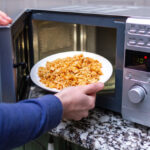Whether left out at room temperature or stored in the fridge, food tends to degrade and lose its appeal over time.
Reheating food in the microwave generates heat from within, quickly warming it from the inside out. This preserves the food’s quality, nutrients, and safety without the risk of wave exposure.

The safest and most reliable method, applicable to all types of food, is to reheat in intervals and check after each minute.
Soups and Broths
When it comes to liquid dishes like soups and broths, reheating in the microwave is ideal. Place the soup in a bowl (avoid metal) and heat it at around 100 degrees Celsius for about 4 minutes. Be mindful not to overheat, as this can cause the liquid to evaporate and the soup to become too salty.
Grilled Dishes
Meat, fish, and vegetables are commonly reheated grilled items, each requiring a unique approach.
For grilled meat and fish – Lightly coat the food with oil and place it on a heat-resistant glass plate. Set the microwave to grill or reheat mode at a temperature not exceeding 120 degrees Celsius for 5-10 minutes.
Boiled and Steamed Dishes
Along with grilled foods, boiled and steamed dishes are also commonly reheated. However, these should only be microwaved for a short duration at a moderate temperature, approximately 2-3 minutes.
Baked Goods
Items like pizza, bread, and sponge cake are typically enjoyed fresh and tend to lose their appeal when cooled. To reheat, wrap the item in specialized food-grade foil and place it in the microwave. Adjust the time between 3-5 minutes and the temperature according to the type and quantity of the baked good. After reheating, you’ll have a delicious, warm treat as if it just came out of the oven.
Tips for Reheating Food in the Microwave
Spread food evenly on a plate and lightly coat the surface with oil to prevent dryness and sticking.
Never use metal containers in the microwave to avoid potential fire hazards.
Be cautious when reheating meat and fish, as they can easily burn if overheated.
Clean the microwave after each use to prevent food odors from lingering and to extend the appliance’s lifespan.
Avoid reheating oily foods in the microwave, as it lacks a grease tray, making cleaning challenging and potentially impacting safety due to uncontrollable oil temperatures.
Do not use narrow-necked bottles or jars, as they can be difficult to remove and may cause burns.
Source: Gia đình và xã hội
The Ultimate Hack to Revive Leftover Rice: A Sprinkle of Magic
When reheating rice in the microwave, there’s a simple trick to ensure it doesn’t dry out and become hard. By adding a small amount of water and covering the bowl, you can retain the moisture and fluffiness of freshly cooked rice. This method ensures your rice is not only warm but also delicious and fragrant.














